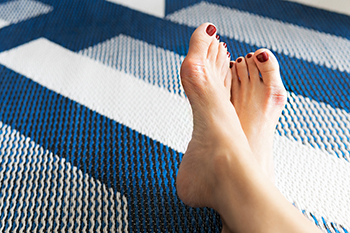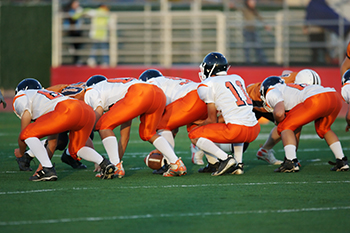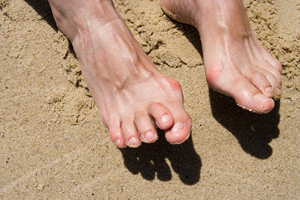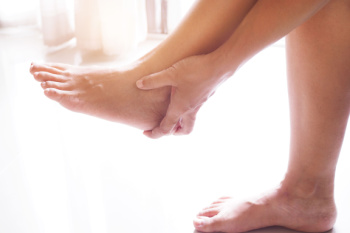Connect With Us
Blog
Items filtered by date: March 2024
Do You Suffer From Painful Feet?
Conservative Treatments for Bunions
 Bunions are bony bumps that form on the joint at the base of the big toe, resulting from the misalignment of the foot's bones. This misalignment causes the big toe to lean toward the second toe, rather than pointing straight ahead, which creates a visible protrusion on the side of the foot. Bunions can cause pain, soreness, and swelling, especially when wearing tight-fitting shoes that press against the bump. There are conservative treatments for less severe cases, such as wearing wider and more comfortable shoes that provide ample space for the toes, and using padded shoe inserts to distribute pressure evenly across the foot. Special exercises that strengthen the foot and improve flexibility can also help manage bunion symptoms. These non-invasive treatments aim to relieve discomfort and prevent the progression of the bunion without the need for surgical intervention. However, more severe cases of bunions may warrant surgery. If you have a bunion, it is suggested that you schedule an appointment with a podiatrist to discuss treatment and measures you can take to prevent the condition from worsening.
Bunions are bony bumps that form on the joint at the base of the big toe, resulting from the misalignment of the foot's bones. This misalignment causes the big toe to lean toward the second toe, rather than pointing straight ahead, which creates a visible protrusion on the side of the foot. Bunions can cause pain, soreness, and swelling, especially when wearing tight-fitting shoes that press against the bump. There are conservative treatments for less severe cases, such as wearing wider and more comfortable shoes that provide ample space for the toes, and using padded shoe inserts to distribute pressure evenly across the foot. Special exercises that strengthen the foot and improve flexibility can also help manage bunion symptoms. These non-invasive treatments aim to relieve discomfort and prevent the progression of the bunion without the need for surgical intervention. However, more severe cases of bunions may warrant surgery. If you have a bunion, it is suggested that you schedule an appointment with a podiatrist to discuss treatment and measures you can take to prevent the condition from worsening.
If you are suffering from bunions, contact one of our podiatrists of Foot & Ankle Surgical Group. Our doctors can provide the care you need to keep you pain-free and on your feet.
What Is a Bunion?
A bunion is formed of swollen tissue or an enlargement of boney growth, usually located at the base joint of the toe that connects to the foot. The swelling occurs due to the bones in the big toe shifting inward, which impacts the other toes of the foot. This causes the area around the base of the big toe to become inflamed and painful.
Why Do Bunions Form?
Genetics – Susceptibility to bunions are often hereditary
Stress on the feet – Poorly fitted and uncomfortable footwear that places stress on feet, such as heels, can worsen existing bunions
How Are Bunions Diagnosed?
Doctors often perform two tests – blood tests and x-rays – when trying to diagnose bunions, especially in the early stages of development. Blood tests help determine if the foot pain is being caused by something else, such as arthritis, while x-rays provide a clear picture of your bone structure to your doctor.
How Are Bunions Treated?
- Refrain from wearing heels or similar shoes that cause discomfort
- Select wider shoes that can provide more comfort and reduce pain
- Anti-inflammatory and pain management drugs
- Orthotics or foot inserts
- Surgery
If you have any questions, please feel free to contact our office located in Henderson, NV . We offer the newest diagnostic and treatment technologies for all your foot care needs.
Symptoms of Turf Toe

Turf toe, a common injury among athletes, occurs when the ligaments surrounding the big toe joint are sprained due to forceful pushing during activities like running or jumping. Turf toe injuries typically happen during sports practice, and are common in football and soccer. An early sign of turf toe is foot pain, which often intensifies with movement. This discomfort may lead to limping or difficulty in walking, occasionally rendering you immobile for a brief period. Sometimes a popping sound in the joint may indicate turf toe. Severe cases may necessitate immobilization or even surgery. It is extremely important not to ignore symptoms of turf toe, as early intervention can accelerate recovery and prevent long-term complications. If you are experiencing persistent pain or limited mobility in your big toe joint, it is suggested that you schedule an appointment with a podiatrist for a diagnosis. This medically trained foot doctor can perform imaging tests, a physical examination, and develop a treatment plan to address your specific needs.
Toe pain can disrupt your daily activities. If you have any concerns, contact one of our podiatrists of Foot & Ankle Surgical Group. Our doctors can provide the care you need to keep you pain-free and on your feet.
What Causes Toe Pain?
Most severe toe pain is caused due to a sports injury, trauma from dropping something heavy on the toe, or bumping into something rigid. Other problems can develop over time for various reasons.
Toe pain can be caused by one or more ailments. The most common include:
- Trauma
- Sports injury
- Wearing shoes that are too tight
- Arthritis
- Gout
- Corns and calluses
- Hammertoe
- Bunions
- Blisters
- Ingrown toenails
- Sprains
- Fractures (broken bones)
- Dislocations
When to See a Podiatrist
- Severe pain
- Persistent pain that lasts more than a week
- Signs of infection
- Continued swelling
- Pain that prevents walking
Diagnosis
In many cases the cause of toe pain is obvious, but in others, a podiatrist may want to use more advanced methods to determine the problem. These can range from simple visual inspections and sensation tests to X-rays and MRI scans. Prior medical history, family medical history, and any recent physical traumatic events will all be taken into consideration for a proper diagnosis.
Treatment
Treatments for toe pain and injuries vary and may include shoe inserts, padding, taping, medicines, injections, and in some cases, surgery. If you believe that you have broken a toe, please see a podiatrist as soon as possible.
If you have any questions please feel free to contact our office located in Henderson, NV . We offer the newest diagnostic tools and technology to treat your foot and ankle needs.
Preventing Hammertoe

If one of your toe joints points upward instead of lying flat, it might indicate a condition known as hammertoe, where weakened toe muscles exert pressure on tendons and joints. This deformity can hinder walking and limit certain activities. Early intervention and preventive measures can help to avoid complications. Hammertoes affect the proximal interphalangeal joint, or PIPJ, causing the middle joint to flex upward. Ill-fitting shoes, especially those with narrow fronts or high heels, commonly trigger this condition. Rheumatoid arthritis or bunions can also contribute. Treatment includes wearing properly sized shoes and using splints or orthotic inserts. Surgery may be necessary for severe cases. Home exercises like toe stretches can help alleviate symptoms. Prioritize footwear comfort to prevent hammertoes and bunions from forming due to prolonged pressure on the toes. If you have a hammertoe that is causing you discomfort, it is suggested that you make an appointment with a podiatrist for an examination and relief methods.
Hammertoe
Hammertoes can be a painful condition to live with. For more information, contact one of our podiatrists from Foot & Ankle Surgical Group. Our doctors will answer any of your foot- and ankle-related questions.
Hammertoe is a foot deformity that affects the joints of the second, third, fourth, or fifth toes of your feet. It is a painful foot condition in which these toes curl and arch up, which can often lead to pain when wearing footwear.
Symptoms
- Pain in the affected toes
- Development of corns or calluses due to friction
- Inflammation
- Redness
- Contracture of the toes
Causes
Genetics – People who are genetically predisposed to hammertoe are often more susceptible
Arthritis – Because arthritis affects the joints in your toes, further deformities stemming from arthritis can occur
Trauma – Direct trauma to the toes could potentially lead to hammertoe
Ill-fitting shoes – Undue pressure on the front of the toes from ill-fitting shoes can potentially lead to the development of hammertoe
Treatment
Orthotics – Custom made inserts can be used to help relieve pressure placed on the toes and therefore relieve some of the pain associated with it
Medications – Oral medications such as anti-inflammatories or NSAIDs could be used to treat the pain and inflammation hammertoes causes. Injections of corticosteroids are also sometimes used
Surgery – In more severe cases where the hammertoes have become more rigid, foot surgery is a potential option
If you have any questions please contact our office located in Henderson, NV . We offer the newest diagnostic and treatment technologies for all your foot and ankle needs.
Causes and Treatments for Plantar Fasciitis

Heel pain is often caused by plantar fasciitis, which is an inflammation of the fascia running along the sole of the foot. Diagnosis of plantar fasciitis relies on symptoms such as morning pain and can be exacerbated by factors like obesity, flat feet, or excessive standing on hard surfaces. There are various relief techniques that affected individuals can take advantage of, and a podiatrist can guide you toward the methods that are best for you. If you have chronic heel pain, it is suggested that you schedule an appointment with this type of doctor who can perform an accurate diagnosis and get you the right treatment.
Many people suffer from bouts of heel pain. For more information, contact one of our podiatrists of Foot & Ankle Surgical Group. Our doctors can provide the care you need to keep you pain-free and on your feet.
Causes of Heel Pain
Heel pain is often associated with plantar fasciitis. The plantar fascia is a band of tissues that extends along the bottom of the foot. A rip or tear in this ligament can cause inflammation of the tissue.
Achilles tendonitis is another cause of heel pain. Inflammation of the Achilles tendon will cause pain from fractures and muscle tearing. Lack of flexibility is also another symptom.
Heel spurs are another cause of pain. When the tissues of the plantar fascia undergo a great deal of stress, it can lead to ligament separation from the heel bone, causing heel spurs.
Why Might Heel Pain Occur?
- Wearing ill-fitting shoes
- Wearing non-supportive shoes
- Weight change
- Excessive running
Treatments
Heel pain should be treated as soon as possible for immediate results. Keeping your feet in a stress-free environment will help. If you suffer from Achilles tendonitis or plantar fasciitis, applying ice will reduce the swelling. Stretching before an exercise like running will help the muscles. Using all these tips will help make heel pain a condition of the past.
If you have any questions please contact our office located in Henderson, NV . We offer the newest diagnostic and treatment technologies for all your foot and ankle needs.


